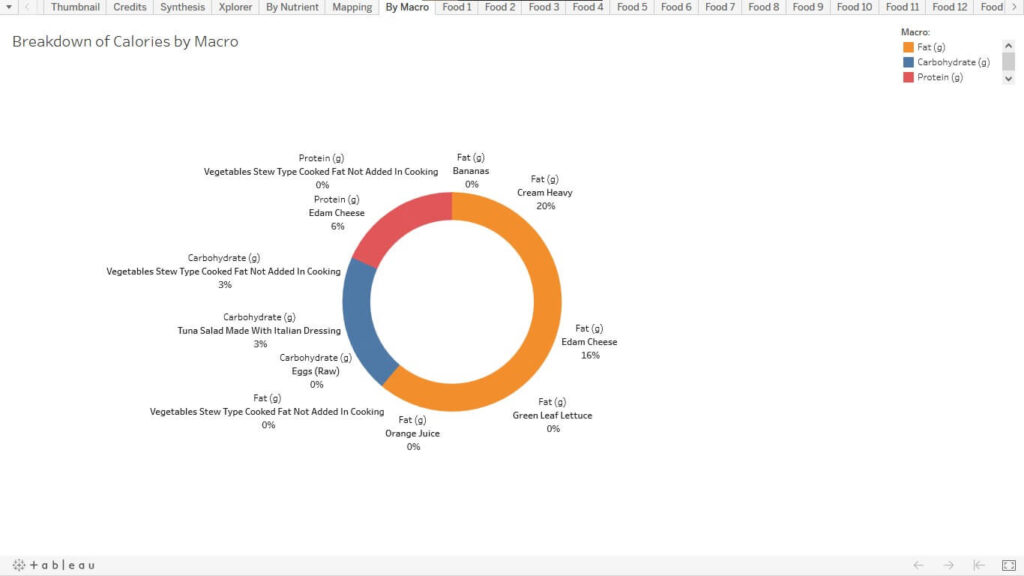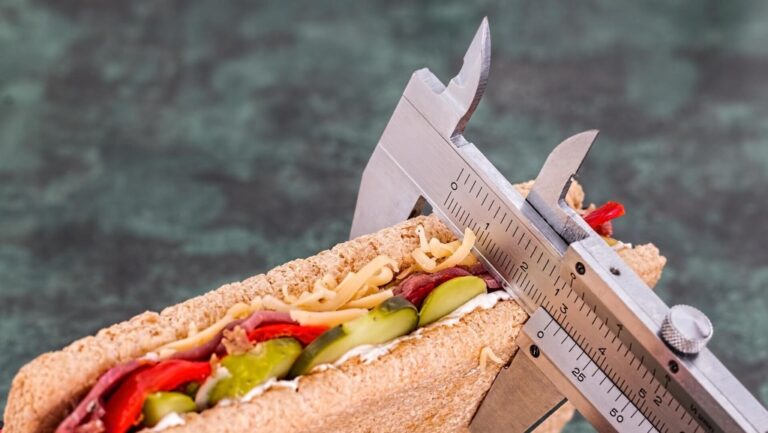[I would like to dedicate this post to a friend of mine who lost his father to COVID-19. Dear friend, thank you for pushing me to do my best and inspiring me through your seamless leadership.]
Too Long; Didn’t Read
To save you time, here is the link to µNutrient, the micronutrient calculator.
You can use the tool online but it will be a bit laggy (the database is voluminous).
I advise you to download it instead (desktop only) by following the steps below:


To open the Tableau workbook, you will also need to download Tableau Reader (choose the most recent version).

However, before you use the tool, I would strongly advise you to read the rest of this article to make the most of it.
Disclaimer: I am not a medical doctor and this is not medical advice. This is strictly a personal project I did for the technical challenge.
Micro-What?
I would like to ask you a question!
Do you really know what you’re getting inside your body every day?
If you think about it, your body is your most essential and primordial territory.
You need to defend it against outside and even inside attacks (autoimmune diseases, etc.).
Although invisible, this “inner shelter” is perhaps the lowest and most important level on Maslow’s Pyramid.
This can take the form of unconscious/passive defense mechanisms like the immune system.
Or it can take on more conscious/active forms like examining one’s nutrition or even breathing techniques.
Hard Nut to Crack!
In an ideal world, it should be effortless to provide our bodies with the right nutrition.
Just like monkeys are attracted to ripe fruits and mountain goats instinctively lick minerals.
Yet, this contradicts the growing trend of prevailing obesity around the world.
What gives?
The short answer could be that it has become too hard to lead a healthy lifestyle.
However, the full picture is more nuanced : consumerism, sedentary lifestyle, GMOs, artificial selection, soil nutrient depletion, processed foods, rising stress levels, public health policies etc.

On top of that, there is individual variation: what’s good for you, could be harmful for someone else…
This is why, we will cut through the noise, to arrive at something both practical and actionable at the individual level.
To do this, we need to go further and dive into ALL the micronutrients that the human body needs.
This article is the first part of the personal answer that I have come up with over the course of the last few months of trial and error.
This series is meant to appeal to three audiences with different interests:
- Simple, free, online micronutrient calculator;
- Specific diets (Ketogenic, Mediterranean, Bulking etc.);
- Technical side (MS Excel, Tableau Desktop and Tableau Public).
I will leave the technical aspect and the diet aspects for another time, so that more people can benefit first from the micronutrient calculator.
Spill The Beans – What Is µNutrient?
Pronounced muNutrient, this (pear-to-pear) solution allows you to track your nutrient intake and compare it with the Daily Recommended Intake figures.
The idea came to me a few months ago when I wanted to improve my nutrition and lose some quarantine pounds.
For years, I used to think in terms of macronutrients (calories in, calories out).
As time went by, I understood that this was a superficial and simplistic approach.
The human body is a formidable machine that requires many inputs to function properly.
The Excel files I used to use for tracking macronutrients could not be scaled to track the micronutrients of even a handful of foods. I needed something else.
They also require manual entry for each food, sometimes from diverging sources.
Thus, I set out on a googling journey to find a practical solution to this problem.
I quickly understood that all the options out there would either:
- Require you to sign up and log in;
- Store and share your personal nutrition data;
- Hide behind a paywall;
- Lack transparency in their calculations;
- Cite no sources to their data;
- Have a limited choice of foods;
- Or all of the above.
I decided in the end to make my own custom-made solution and share it for free.
With A Pinch of Salt – Why trust µNutrient?
Simply put, you should not trust it.
Double check its results with other sources.
Ultimately, you should talk to a professional dietician for any diagnostic or course of action.
This is a tool meant to provide approximative results for what can be measured and then compare it with published references.
Nothing less, nothing more.
However, this project would be meaningless without a trusted, reliable source of data.
Beyond the technical hurdles, my true motivation has always been learning more about nutrition.
This is why I decided to go with the USDA Food Data Central for the nutrition food profiles.
More precisely, I used the spreadsheet provided by MyFoodData.
It is an easier to use flat-file version of the multiple raw files published by the USDA.
As for the Daily Recommended Intakes (DRIs), they were sourced either from the NCBI website or from MyFoodData.
All links are availble on the Credits tab of the dashboard.
Icing on the Cake – Tableau Public
I wanted actionable insights so I decided that I needed a dashboard, rather than a typical calculator layout.
Tableau Desktop naturally came to mind as a powerful and versatile visualization solution.
The icing on the cake is that I could also use another service from the same company: Tableau Public.
It allows me to reuse the same file from Tableau Desktop and share it online with people for free!
Piece of Cake – User Interface
The interface was designed with ease of use in mind.
Here’s the breakdown of the tabs in the interface:

Synthesis (1):
This is the main tab where you enter input as (food choice; quantity in grams);
You can visualize a detailed breakdown of your entire diet by nutrient and more.

Xplorer (2):
This tab was created to allow you to see the content of a food without affecting the diet you already entered on the Synthesis tab.

By Nutrient (3):
Chart showing the breakdown of the selected nutrient intake per source.

Mapping (4):
Similar to By Nutrient, but sources are compared side to side, instead of being visualized as a part to a whole.

By Macro (5):
Visualize the macronutrient distribution of your total caloric intake as well as the contribution of each food to it.

Food 1 to Food 15 (6):
Linked to the Synthesis tab. These tabs show you the separate contribution of each pair of food to your diet for each nutrient.
Carrot and Stick – Possible Use Cases
µNutrient can be used in a variety of situations thanks the built-in visualization features of Tableau and the tabular/modular design of the dashboard.
Food for Thought – Audit
It can be used to audit your current diet and look for potential deficiencies.
Cherry Pick – Explore
You can use it to learn about the nutrient content of specific foods.
Bigger Fish to Fry – Optimize
For the more ambitious ones, it can be used to create a custom-tailored diet that satisfies your personal goals and constraints.
Assuredly one of the most rewarding use cases.
You Can’t Make an Omelet Without Breaking Some Eggs – Intervene
My preferred use is the tactical Guerilla mode where you try to save the day by evaluating how far off your daily target you are and subsequently adjusting the next meal.
This is quite powerful because it can prevent you from falling in a downward spiral where you feel like you already lost the day, then the week etc.
Bite Off More Than You Can Chew – Limitations
With great convenience, come even greater inconveniences!
There are many limitations to this tool. Some technical and other more “functional”.
We will address some of the functional issues linked to nutrition itself.
There’s No Such Thing as a Free Lunch – Cooking Method
The cooking or preparation method you use immensely impacts the nutrition profile of your foods.
Heat and cooking time tend to destroy some nutrients, especially vitamins.
You can find more information about it on the internet or consult a dietician.
The quick fix is to make sure you have a sufficient buffer of nutrients for the foods you intend to cook.

All One’s Eggs in One Basket – Superfoods Trap
Another limitation, coming from the user, is that you could be tempted to eat 4 pounds of Broccoli or any other nutrient-dense foods to hack the system and get almost all your needs with a very low-calorie diet.
That is a recipe for disaster. You should prioritize diversity of foods and never attempt to hack anything, especially not your health.
Some nutrients are more easily absorbed in combination with others…
This is why a professional opinion is always required before applying any changes to your diet, especially extreme ones.
Low-Hanging Fruit – Cheap is Expensive
Cheaper options might have lower quality nutrients that are damaged or harder to absorb etc.
In contrast, whole foods are a healthy option and can cost less than processed foods over the long-term (including health bills).

Too Many Cooks Spoil the Broth – Consistency
Diets are notorious for being hard to follow over the long-term.
All the more reason to design your diets to not only be healthy, but also sustainable and enjoyable.
Consistency is key here.

You Can’t Have Your Cake and Eat It – Saving Progress
From a technical point of view, this tool is not a perfect solution either.
One of the limits of Tableau Public is that you cannot natively update the data source.
Still, I believe the thousands of food options on the current version are probably sufficient for 95% of the people out there.
As far as saving progress, I currently have no way of storing the input data, aside from taking screenshots of the Synthesis tab.
I would welcome any solution to this problem if you have one!
In A Nutshell
Nutrition is an interesting topic because it is a very personal phenomenon.
Since antiquity, food has been considered akin to medicine for the body.
It is even used as a form of self-expression and cultural identification.
In the end, this project is merely an attempt at finding the missing link between the dominant macroscopic aspect of nutrition in our globalized sociocultural system and the microscopic dimension of nutrition our bodies operate within.
I hope this article helped you or ignited an interest in you for micronutrition.
Thank you for reading and stay tuned for the next post.

1 thought on “Try this Free Micronutrient Calculator I Made on Tableau”